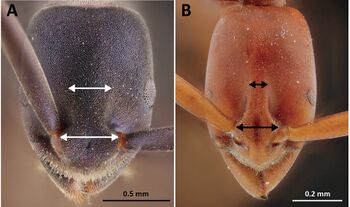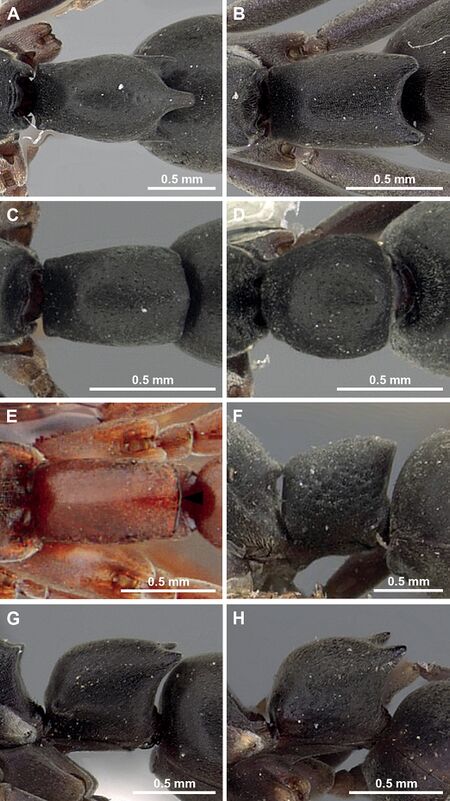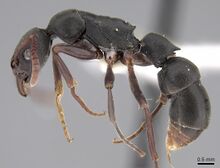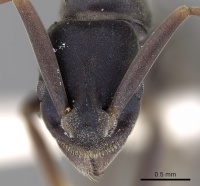Key to Platythyrea of southeast Asia
This key to species Southeast Asian Platythyrea is based on Phengsi et al. (2018) and Jaitrong et al. (2022).
1
- Frontal carinae very widely spaced, not continuing beyond level of posterior margin of antennal insertions (Fig. 1A); propodeal spiracle opening circular => 2
- Frontal carinae relatively narrowly separated, extending far beyond level of posterior margin of antennal insertions where space between them is very narrow (Fig. 1B); propodeal spiracle opening elliptical => 8
2
return to couplet #1
- In dorsal view, posterior margin of petiole with 2 or 3 distinct spines, teeth or blunt angles (Figs 7A, B; Fig. 8A, B) => 3
- In dorsal view, posterior margin of petiole without distinct spines, teeth or sharp angles (Fig. 7C; Fig. 8C) => 6
3
return to couplet #2
- In dorsal view, posterior margin of petiole clearly concave with distinct lateral blunt angles; in profile view, petiole almost as long as high => 4
- In dorsal view, posterior margin of petiole with 3 distinct spines; in profile view, petiole longer than high (Fig. 7A) => Platythyrea tricuspidata
4
return to couplet #3
- In full-face view, head oval, almost as long as broad, posterior margin broadly convex (Fig. 8A); in profile view, posterodorsal corner of petiole nearly right angle (Fig. 7F) => Platythyrea sagei
- In full-face view, head subrectangular, slightly longer than broad, posterior margin broadly almost straight or weakly concave (Fig. 8B); in profile view, posterodorsal corner of petiole bearing truncate spine (Fig. 7G) => 5
5
return to couplet #4
- In profile view, propodeum armed with a pair of short teeth or tubercles (Fig. 9); in profile view, lateral face of pronotum punctate, with dense foveae; lateral face of petiole wrinkled; in profile view, dorsal outline of petiole roundly convex (Fig. 7H) => Platythyrea quadridenta
- In profile view, propodeum unarmed; in profile view, lateral faces of pronotum and petiole rather smooth, without foveae; in profile view, dorsal outline of petiole almost straight or weakly convex (Fig. 7G) => Platythyrea bidentata
6
return to couplet #2
- In full-face view, head elongate (CI < 77), posterior margin deeply concave => Platythyrea nicobarensis
- In full-face view, head elongate (CI > 77), posterior margin shallowly concave => 7
7
return to couplet #6
- In dorsal view, petiole clearly longer than broad; antennal scape relatively short, not reaching posterolateral corner of head => Platythyrea parallela
- In dorsal view, petiole almost as long as broad; antennal scape relatively long, slightly extending beyond posterolateral corner of head => Platythyrea inermis
8
return to couplet #1
- Lateral face of head and pronotum punctate, with dense foveae (Fig. 5A1); antennal scape relatively short (SI = 125–138); smaller species (TL 5.74–6.20; HW 0.86–0.89); eye with 5 or 6 ommatidia on longest axis => Platythyrea clypeata
- Lateral face of head and pronotum finely micopunctate (Figs 5B1, 5C1); antennal scape relatively long (SI > 150); larger species (TL 7.59–7.80; HW 1.06–1.12) => 9
9
return to couplet #8
- Head narrower posteriorly (Fig. 3B). Dorsal outline of petiole weakly convex, posterior margin of petiolar node without a concavity in the middle (Fig. 7E). Body surface with thin pubescence (Fig. 3A). Eyes with 7 or 8 ommatidia on longest axis (Fig. 5B2) => Platythyrea homasawini
- Head not narrower posteriorly (Fig. 4B). Dorsal outline of petiole almost straight, posterior margin of petiolar node with a concavity in the middle. Body surface with thick pubescence (Fig. 4A). Eyes with 9–11 ommatidia on longest axis (Fig. 5C2) => Platythyrea janyai
References
- Jaitrong, W., Xu, Z., Khachonpisitsak, S. 2022. A new species of the ant Platythyrea clypeata species group (Hymenoptera, Formicidae, Ponerinae) from continental Asia. ZooKeys 1115, 151–168 (doi:10.3897/zookeys.1115.86477).
- Phengsi, N., Jaitrong, W., Ruangsittichai, J., Khachonpisitsak, S. 2018, A sibling species of Platythyrea clypeata Forel, 1911 in southeast Asia (Hymenoptera, Formicidae, Ponerinae). ZooKeys 729: 87–102 (DOI 10.3897/zookeys.729.21378).





















